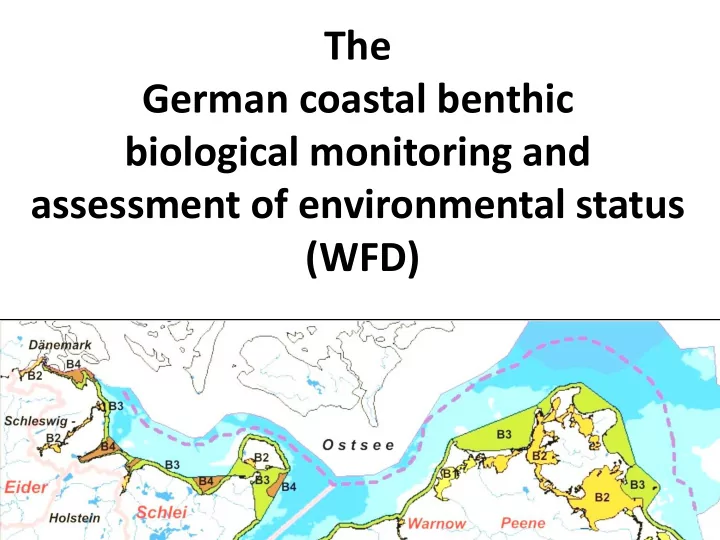

The German coastal benthic biological monitoring and assessment of environmental status (WFD)
Baltic Sea types – outer shallow water bodies border of river basin border of territorial waters (12 sm) oligohaline inner coastal waters mesohaline inner coastal waters mesohaline outer coastal waters meso- polyhaline outer coastal waters, seasonally stratified
border of river basin border of territorial waters (12 sm) oligohaline inner coastal waters mesohaline inner coastal waters mesohaline outer coastal waters meso- polyhaline outer coastal waters, seasonally stratified
the normative definitions and their application in BALCOSIS H igh Status: „All disturbance-sensitive macroalgae and angiosperm taxa associated with undisturbed conditions are present. The levels of macroalgal cover and angiosperm abundance are consistent with undisturbed conditions.“ metrics: perennial species (or ephemeral opportunists as antagonists ) diversity aspects (where applicable and feasible) area , cover or depth limits BALCOSIS assessment system of ecological quality ( outer Baltic Sea coast) • Zostera depth limit ( ≥ 10% cover) [m] • Fucus depth limit ( ≥ 10% cover) [m] • opportunists in Zostera meadows [% biomass] • cover of Fucus on stones (0-2 m) [% cover] • opportunists on stones (5-7 m) [% biomass] • number of selected perennial species [n of 10] • portion of Furcellaria on stones (5-7 m) [% biomass]
Baltic Sea types – inner shallow water bodies border of river basin border of territorial waters (12 sm) oligohaline inner coastal waters mesohaline inner coastal waters mesohaline outer coastal waters meso- polyhaline outer coastal waters, seasonally stratified
the normative definitions and their application in PHYBIBCO H igh Status: „All disturbance-sensitive macroalgae and angiosperm taxa associated with undisturbed conditions are present. The levels of macroalgal cover and angiosperm abundance are consistent with undisturbed conditions.“ metrics: perennial species (or ephemeral opportunists as antagonists ) diversity aspects (where applicable and feasible) area , cover or depth limits PHYBIBCO assessment system of ecological quality ( inner Baltic Sea coast) • Angiosperm depth limit ( ≥ 10% cover) [m] • Characean depth limit ( ≥ 10% cover) [m] • dominant macrophyte-community [score]
Zostera mapping German Baltic Sea by GEOMAR Kiel Methods • Tow-camera along line transects • Transects ran parallel and perpendicular to the coast • Total length of all transects: > 400 km • Parameter: eelgrass cover in 6 classes
the normative definitions and their application in PHYBIBCO invertebrate benthic fauna • - diversity and abundance of taxa • - all disturbance sensitive taxa present (coastal Baltic Sea und Helgoland:) the MarBIT-Index, 4 modules: species diversity (taxonomic spread) Abundance (lognormal-distribution) proportion of sensitive species proportion of tolerant species
Benthic Monitoring in the German EEZ Habitats directive : sandbanks (3) & reefs (3 areas) - every site: focus area (10 – 15 stations) once per period - overview monitoring (3-4 stations) every year in all areas - assessment („ biological quality “): sandbanks : BQI & site specific species inventory reefs : site specific species inventory & NN (under development) - „ Extent and distribution “ No task for monitoring (desk top studies)
MSFD : mud & sand : predominant habitats (EUNIS level 2/3) – monitoring system under development Coarse sand & gravel: special habitats – currently no monitoring planned current draft : 3 basins 2x per period Mecklenburg Bay: mud wih Arctica Arkona basin: mud with Macoma Pomeranian Bight: sand with CMM few HELCOM monitoring stations for interannuell variability planned: spatial distributionb of samples assessment: BQI (Arctica-indicator in MB)
Recommend
More recommend